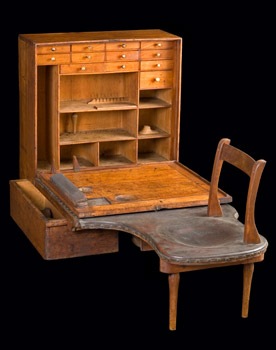It was Steve Jobs who invented minimalism. No, scratch that, it was Mies van der Rohe. Unless, wait, it was the Shakers? When it comes to reducing things to their simplest form and function, that rural sect of technology-averse dissenters helped shape our modern world. Looking at the various artifacts in Gather Up the Fragments: The Andrews Shaker Collection, you’re struck by the relentless editing. It’s not just the frivolity and fanciness that have been excised, nor the cost of extra materials. Rather, there’s the relentless planing away of superfluous ideas. The function of one object—a “pie safe,” for instance, carefully screened to keep away flies—suggests no other object. No two purposes overlap. There’s no confusion about what’s what. It’s the opposite of the “spork” (spoon + fork = spork). With the Shakers, the spoon and fork are always kept separate. Those signature oval wooden boxes remind you of nothing else. They are for storage with no hard-to-clean corners. Likewise, a coatrack or bowl or cabinet or chair has the quintessence of a child’s drawing; and all that a child can imagine requires considerable adult honing of extraneous thoughts. (Don’t confuse this with mere plainness; there are surprising daubs of color here, like some green-tinted glasses that would’ve been chic in ‘60s Carnaby Street.) The Shaker ethos takes an eraser to the grown-up’s blueprint, humbles the ambition toward what we call, today, extra features. There are no extras in Shaker design—just onlys. BRIAN MILLER
Tuesdays-Sundays, 11 a.m.-5 p.m. Starts: July 28. Continues through Oct. 28, 2012




